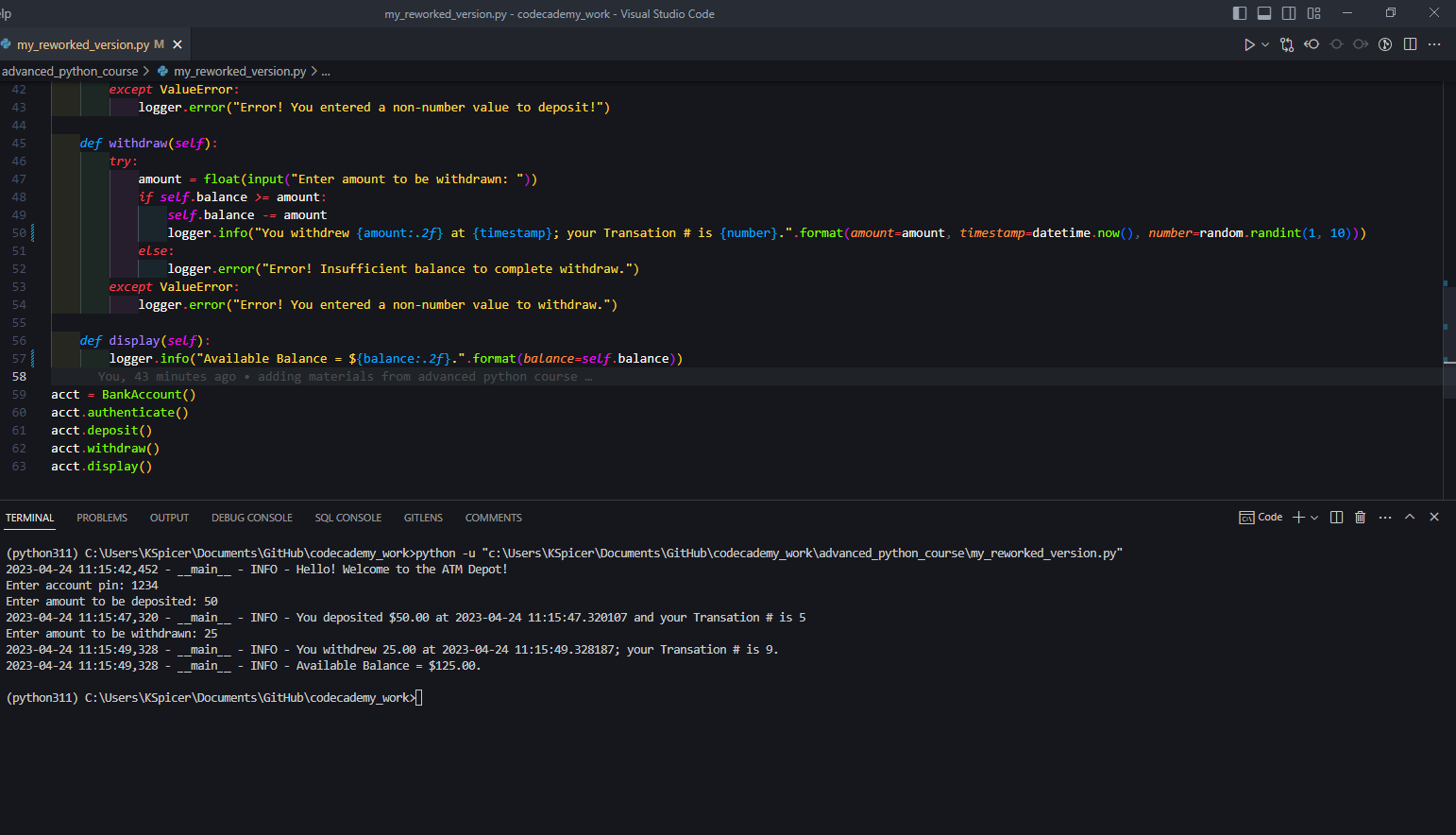4 minutes
Advanced Logging in Python
Over this past weekend I was working my through Codecademy’s “Advanced Python 3” course, which has an initial module that introduces students to Python’s logging library. There was a wonderful little project—“ATM Logging”—that was quite fun to tackle, especially as it made really clear why one might want to use logging instead of filling one’s code with a bunch of print() statements. The setup was that we had a pretty simple little “ATM” program/script that would allow us to deposit and withdraw money—while providing some error messages to keep track of things throughout the whole process. This is what my fiddling around here looked like.
So, the starter code given was the following:
import random
import logging
import sys
from datetime import datetime
logger = logging.getLogger(__name__)
logger.setLevel(level="INFO")
class BankAccount:
def __init__(self):
self.balance=100
logger.logINFO("Hello! Welcome to the ATM Depot!")
def authenticate(self):
while True:
pin = int(input("Enter account pin: "))
if pin != 1234:
print("Error! Invalid pin. Try again.")
else:
return None
def deposit(self):
try:
amount=float(input("Enter amount to be deposited: "))
if amount < 0:
print("Warning! You entered a negative number to deposit.")
self.balance += amount
print("Amount Deposited: ${amount}".format(amount=amount))
print("Transaction Info:")
print("Status: Successful")
print("Transaction #{number}".format(number=random.randint(10000, 1000000)))
print("Timestamp: {timestamp}".format(timestamp=datetime.now()))
except ValueError:
print("Error! You entered a non-number value to deposit.")
print("Transaction Info:")
print("Status: Failed")
print("Transaction #{number}".format(number=random.randint(10000, 1000000)))
print("Timestamp: {timestamp}".format(timestamp=datetime.now()))
def withdraw(self):
try:
amount = float(input("Enter amount to be withdrawn: "))
if self.balance >= amount:
self.balance -= amount
print("You withdrew: ${amount}".format( amount=amount))
print("Transaction Info:")
print("Status: Successful")
print("Transaction #{number}".format(number=random.randint(10000, 1000000)))
else:
print("Error! Insufficient balance to complete withdraw.")
print("Transaction Info:")
print("Status: Failed")
print("Transaction #{number}".format(number=random.randint(10000, 1000000)))
except ValueError:
print("Error! You entered a non-number value to withdraw.")
print("Transaction Info:")
print("Status: Failed")
print("Transaction #{number}".format(number=random.randint(10000, 1000000)))
print("Timestamp: {timestamp}".format(timestamp=datetime.now()))
def display(self):
print("Available Balance = ${balance}".format(balance=self.balance))
acct = BankAccount()
acct.authenticate()
acct.deposit()
acct.withdraw()
acct.display()
The task was to see if we could clean things up a little bit here—paring down some of the code (the original had 68 lines), remove extraneous print statements, etc. Just from glancing casually at the code, it might be clear why we would want to do such things. From the point of view of the logging library, there’s much to do here that can be handled in far fewer lines of code. If we utilize all the affordances of the library, we can get something that is much more streamlined and efficient and perhaps much more helpful for users.
import random
import logging
import sys
from datetime import datetime
logger = logging.getLogger(__name__)
logger.setLevel(logging.DEBUG)
# Adding stream handler to logger
stream_handler = logging.StreamHandler(sys.stdout)
formatter1 = logging.Formatter('%(asctime)s - %(name)s - %(levelname)s - %(message)s')
stream_handler.setFormatter(formatter1)
logger.addHandler(stream_handler)
# Adding File handler to logger
file_handler = logging.FileHandler("log_test.txt")
formatter2 = logging.Formatter('%(asctime)s - %(name)s - %(levelname)s - %(message)s')
file_handler.setFormatter(formatter2)
logger.addHandler(file_handler)
class BankAccount:
def __init__(self):
self.balance=100
logger.info("Hello! Welcome to the ATM Depot!")
def authenticate(self):
while True:
pin = int(input("Enter account pin: "))
if pin != 1234:
logger.error("Error! Invalid pin. Try again.")
else:
return None
def deposit(self):
try:
amount=float(input("Enter amount to be deposited: "))
if amount < 0:
logger.warning("Warning! You entered a negative number to deposit.")
else:
self.balance += amount
logger.info("You deposited ${amount: .2f} at {timestamp} and your Transation # is {number}".format(amount=amount, timestamp=datetime.now(), number=random.randint(1, 10)))
except ValueError:
logger.error("Error! You entered a non-number value to deposit!")
def withdraw(self):
try:
amount = float(input("Enter amount to be withdrawn: "))
if self.balance >= amount:
self.balance -= amount
logger.info("You withdrew {amount: .2f} at {timestamp}; your Transation # is {number}.".format(amount=amount, timestamp=datetime.now(), number=random.randint(1, 10)))
else:
logger.error("Error! Insufficient balance to complete withdraw.")
except ValueError:
logger.error("Error! You entered a non-number value to withdraw.")
def display(self):
logger.info("Available Balance = ${balance: .2f}.".format(balance=self.balance))
acct = BankAccount()
acct.authenticate()
acct.deposit()
acct.withdraw()
acct.display()
The cleaned-up version doesn’t really get us fewer lines of code, but it does look much, much more readable and far easier to understand. And the error messages are successfully logged to the proper places, which is the whole point of this, to be sure! Output where we don’t get any error messages looks like this now:

Here’s the output if a user incorrectly/inadvertently enters a negative number:

and if they try to withdraw more funds than they have in their current balance:

This was quite fun and I learned a ton: it’s exceedingly clear to me how useful this logging module is, that’s for sure.
All the work for this project is available in the following repository.
python python library python standard library python logging code cleanup codecademy projects error messages error handling codecademy
708 Words
2023-04-25 00:02